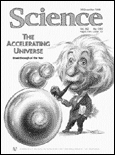1998's Hottest Science Story
Science Magazine Names Discovery of an Accelerating Universe Breakthrough of the Year
By Robert Sanders, Public Affairs
Posted January 13, 1999
 |
The discovery by the two teams that the expansion of the universe is accelerating surprised everyone, and threw a wrench into current cosmological theories. The scientists came to this conclusion after measuring the speed at which distant supernovas are receding from us.
"Both teams are getting the same results with an independent set of supernovas, which means we probably aren't making some great blunder," said Alex Filippenko, professor of astronomy and a member of the High-z Supernova Search Team. "Other astronomers and theorists have to take this seriously."
Leader of the High-z team is Brian Schmidt of the Mount Stromlo and Siding Spring Observatories in Australia. The second, competing team - called the Supernova Cosmology Project - is headed by Saul Perlmutter of Lawrence Berkeley National Laboratory.
"We first noticed that our supernovas seemed dimmer than we expected for their redshift," said physicist Gerson Goldhaber, professor in the graduate school and a member of the Supernova Cosmology Project. "After exhaustive studies, we finally convinced ourselves that the universe's expansion is accelerating, evidently fueled by some mysterious 'dark energy.'"
With the advent of digital CCD cameras and more powerful computers, scientists are discovering an increasing number of supernovas. Both teams use computers to compare photos of the sky taken several weeks apart. When the two photos are digitally subtracted, a bright supernova should stand out starkly.
Just as important, more have been discovered early in their evolution, allowing detailed study of their brightening and dimming. Between them, the two competing teams have found nearly 100 new supernovas in the past few years.
Though much work needs to be done to confirm their results, the teams are excited.
"It's been fantastic" working with the Supernova Cosmology Project, said Goldhaber, a senior scientist at LBNL.
"We are really jazzed that Science magazine decided to do this," Filippenko added.
For information on the discovery and perspective on its implications, see the story "High Excitement at High-Z" in the Dec. 2 issue of Berkeleyan, which can be found by selecting "News and Information" from the campus home page. Read about the research of the Supernova Cosmology Project at www.lbl.gov/supernova/ on LBNL's web site.
![]()
![]()
January 13 - 19, 1999 (Volume 27, Number 19)
Copyright 1999, The Regents of the University of California.
Produced and maintained by the Office of Public Affairs at UC Berkeley.
Comments? E-mail berkeleyan@pa.urel.berkeley.edu.